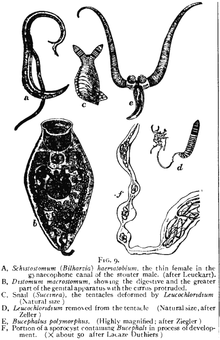Trematoda
Trematoda is a class within the phylum Platyhelminthes. It includes two groups of parasitic flatworms, known as flukes.
They are internal parasites of molluscs and vertebrates. Most trematodes have a complex life cycle with at least two hosts. The primary host, where the flukes sexually reproduce, is a vertebrate. The intermediate host, in which asexual reproduction occurs, is usually a snail.
The trematodes or flukes include 18,000[1] to 24,000[2] species, divided into two subclasses. Nearly all trematodes are parasites of mollusks and vertebrates. The smaller Aspidogastrea, comprising about 100 species, are obligate parasites of mollusks and may also infect turtles and fish, including cartilaginous fish. The Digenea, the majority of trematodes, are obligate parasites of both mollusks and vertebrates, but rarely occur in cartilaginous fish.
Two other parasitic classes, the Monogenea and Cestoda, are sister classes in the Neodermata, a group of Rhabditophoran Platyhelminthes.[3]
Trematodes are flattened oval or worm-like animals, usually no more than a few centimetres in length, although species as small as 1 millimetre (0.039 in) are known. Their most distinctive external feature is the presence of two suckers, one close to the mouth, and the other on the underside of the animal.[4]
The body surface of trematodes comprises a tough syncitial tegument, which helps protect against digestive enzymes in those species that inhabit the gut of larger animals. It is also the surface of gas exchange; there are no respiratory organs.[4]
